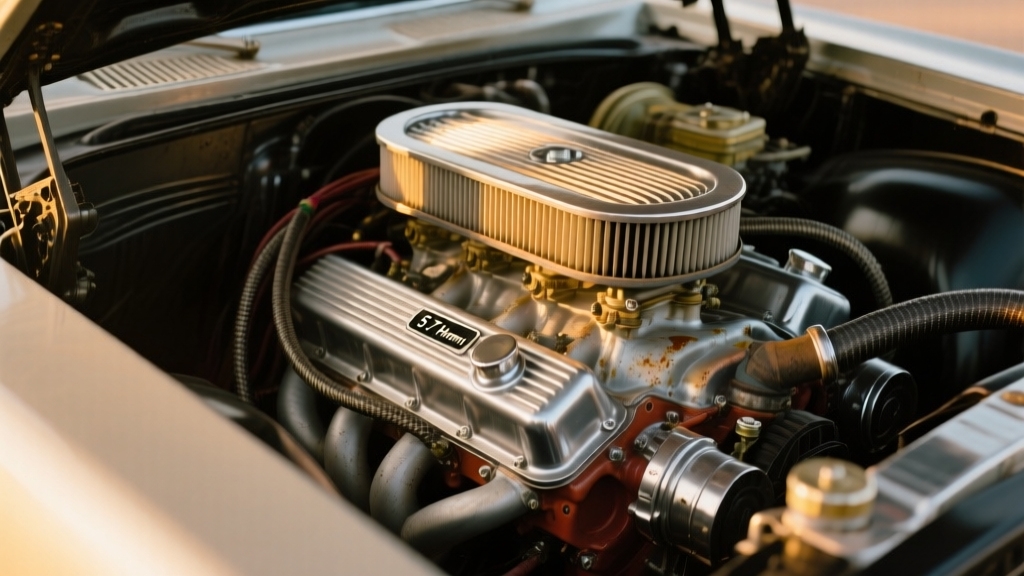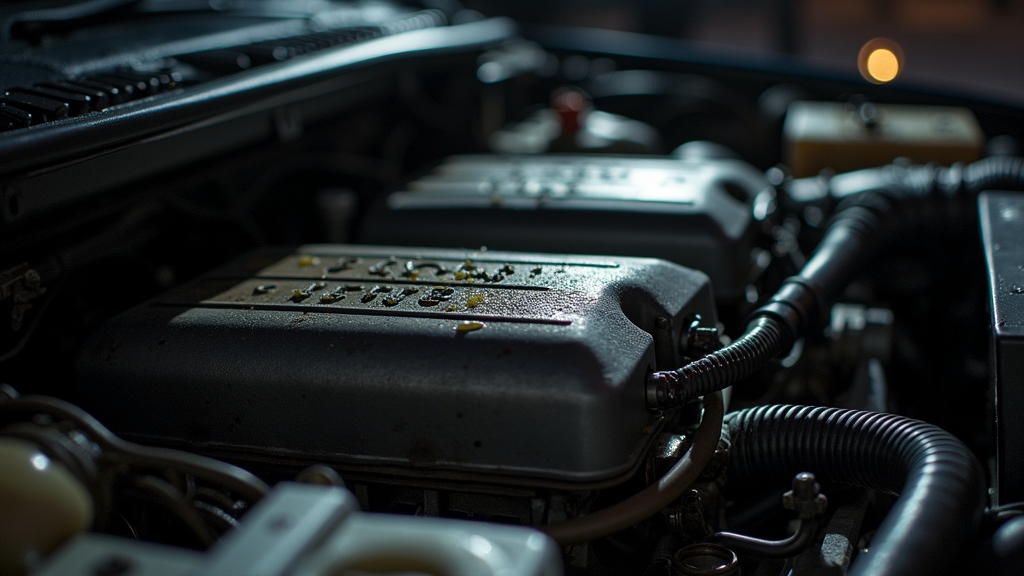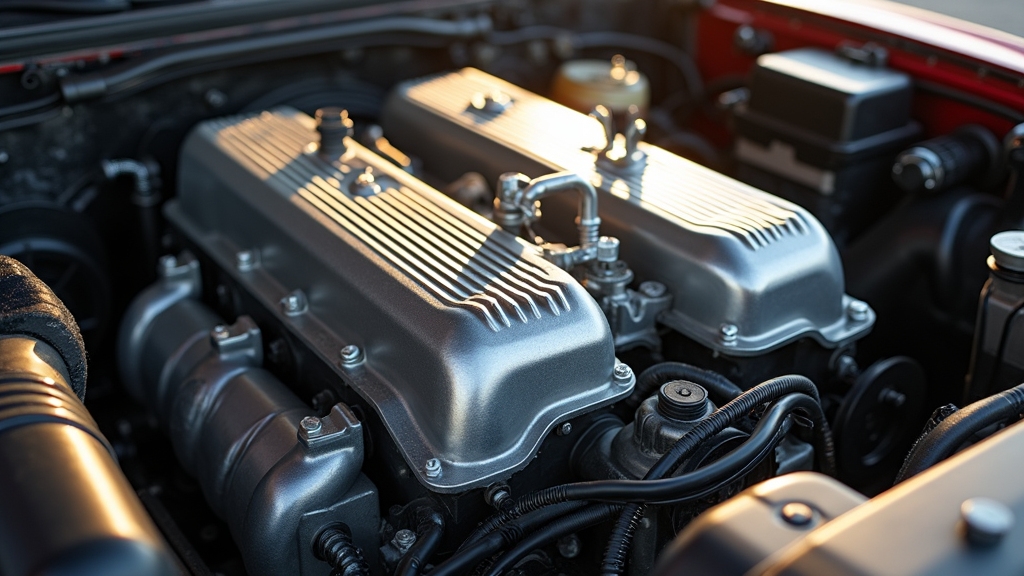Physical Address
304 North Cardinal St.
Dorchester Center, MA 02124
Physical Address
304 North Cardinal St.
Dorchester Center, MA 02124

You can expect your 5.7 Hemi engine to last around 200,000 miles when you maintain it diligently with regular oil changes and quality fuel.
Heavy towing may accelerate wear, particularly on lifters and exhaust components, often seen near 180,000 miles. Adhering to manufacturer service intervals and using synthetic oils help mitigate common issues like camshaft and valve train wear.
Understanding these factors lets you optimize longevity and peak performance in this durable powerplant.

While the 5.7 Hemi engine’s lifespan varies with maintenance and usage, you can typically expect it to reach around 200,000 miles under proper care. This engine frequently surpasses this threshold, with some examples documented at 300,000 miles depending on operational conditions and upkeep. Its strong cast iron crankshaft and durable components contribute significantly to its longevity.
Factors like driving habits and load affect durability, yet well-maintained units consistently achieve high mileage, especially in Ram trucks. Engine longevity correlates strongly with regular synthetic oil changes, adherence to service intervals, and moderate driving. Using high-quality synthetic oils designed for enhanced wear protection can further extend the engine’s life.
Mild highway use extends life expectancy compared to aggressive driving or heavy towing, which still often exceed 150,000 miles. Overall, the 5.7 Hemi demonstrates robust architecture and solid endurance, allowing it to maintain reliability through typical mileage milestones without premature failure in properly managed scenarios.
Because the 5.7 Hemi engine endures extensive use, several mechanical issues can substantially affect its longevity.
Early models frequently encounter exhaust manifold bolt failures, causing ticking noises and exhaust leaks. This requires bolt replacement and resealing. Broken exhaust manifold bolts are the most common issue, causing exhaust leaks and ticking sounds that, while not urgent, should be addressed to prevent further problems.
Exhaust manifold bolts often fail early, leading to leaks and ticking noises requiring prompt repair.
Post-2009 engines risk camshaft lobe flattening, leading to misfires and error codes. This often necessitates camshaft replacement despite proper oil changes. Using motor oils with advanced additive technology can help mitigate some wear issues in these engines.
Early Gen III variants suffer from valve seat dropping, a fundamental flaw causing compression loss and potential catastrophic failure.
Engines with the Multi-Displacement System (MDS) face reliability challenges due to cylinder deactivation faults, which can accelerate wear if unaddressed.
Additionally, oil sludge accumulation, often from poor maintenance or overheating, further degrades engine components. Recognizing these issues early is vital for preserving the 5.7 Hemi’s operational lifespan.
Mechanical issues can shorten the lifespan of your 5.7 Hemi, but consistent maintenance plays a significant role in extending it.
You must adhere to manufacturer-recommended schedules, use correct fluids, and regularly inspect belts, hoses, and filters. Using the proper fluid formulations is essential to ensure system compatibility and performance.
Proper oil type and timely changes preserve engine internals, while fluid monitoring prevents system damage. Early engine break-in and valve train upkeep also influence durability.
Regularly checking the serpentine belt for fraying and cracks helps avoid unexpected accessory failures that could harm the engine.
| Maintenance Aspect | Action | Effect on Lifespan |
|---|---|---|
| Oil & Fluid Maintenance | Timely changes, correct types | Reduces wear, prevents overheating |
| Belt & Hose Inspection | Regular checks, replacements | Prevents failures, avoids leaks |
| Scheduled Component Replacement | Follow intervals | Avoids sudden breakdowns |
| Break-in Procedure | Follow manual guidance | Ensures proper component seating |
How does the type of fuel you use affect the performance and longevity of your 5.7 Hemi engine?
The 5.7 Hemi is calibrated to run efficiently on 87 octane fuel, with 89 octane recommended for ideal performance under load. Some users says no issues using 87 octane, but others experience knocking or hard acceleration on 87, regardless of octane level, highlighting the variability in engine response with different fuels.
Choosing the right oil filter can complement fuel quality, as filters with high filtration efficiency help maintain cleaner engine oil and reduce wear.
Using fuel below recommended octane can cause knocking, prompting the ECM to retard ignition timing, which reduces power and may increase emissions.
Using lower octane fuel causes knocking, forcing timing adjustments that reduce power and raise emissions.
Consistently using the correct octane minimizes pre-ignition risks, protecting internal components over time.
Additionally, fuel quality matters: contaminated or low-detergent fuels can lead to carbon buildup and injector clogging, accelerating wear.
Opting for Top Tier detergent gasoline helps maintain intake valve cleanliness and combustion efficiency.
While premium fuel typically offers no tangible benefits in normal driving, it may be advantageous in demanding conditions like towing, supporting both performance and engine durability, as towing or hauling may benefit from using 89 octane fuel.

Beyond fuel quality and octane considerations, the 5.7 Hemi’s inherent durability stems from its carefully engineered design features.
Its cast iron cylinder block and four-bolt main bearing caps provide exceptional strength and crankshaft stability, essential for withstanding high cylinder pressures. Regular maintenance and timely repairs are crucial to preserving these components’ integrity and preventing premature failure.
Forged connecting rods and lightweight aluminum pistons reduce stress on the rotating assembly, enhancing longevity under load. The hemispherical combustion chambers with two spark plugs per cylinder promote efficient, complete combustion, minimizing carbon buildup. This design also contributes to its power and efficiency.
Advanced cooling and oil management systems maintain stable temperatures and consistent lubrication, preventing component wear. Electronic controls like coil-on-plug ignition and adaptive ECU management optimize timing and reduce misfires.
Addressing issues such as a leaking oil pan gasket promptly can help maintain oil system integrity and engine longevity. Together, these precise engineering choices ensure the 5.7 Hemi endures rigorous operating conditions, delivering reliable performance over extended service intervals.
Although the 5.7 Hemi has proven durable overall, its reliability varies considerably across model years due to design updates and manufacturing changes.
Early models (2003-2008) delivered strong power but frequently exhibited valve seat wear and the characteristic “Hemi tick.” The engine was originally designed with a cast iron block and aluminum heads to balance durability and weight.
Proper maintenance, including regular oil and filter changes using high-quality products like heavy-duty oil filters, can help mitigate wear issues. Mid-period 2005-2006 engines, especially in the Dodge Magnum, suffered from stalling and multiple recalls, with weak exhaust manifold bolts undermining reliability.
Significant improvements arrived in 2009 with variable cam timing and reinforced engine components, enhancing efficiency and durability. However, 2011-2012 Ram models reintroduced cam lifter lubrication issues causing persistent ticking and costly repairs.
From 2013 onward, particularly post-2017 models, refinements in engine design and transmission integration notably reduced failures and extended engine lifespan.
Understanding these year-specific variations helps you anticipate maintenance demands and avoid problematic models.
Many users share their experiences with the 5.7 Hemi engine, and it’s pretty impressive. A lot of folks says that with regular maintenance—like using synthetic oil and changing spark plugs—they can easily surpass 200,000 miles.
Using high mileage oils can further help reduce engine wear and extend life. That’s quite a milestone, right? In fact, the engine can last up to 250,000–300,000 miles with proper care.
But there’s a catch. If you’re towing heavy loads on the regular, that might speed up wear on the lifters and valve train components.
So, while the engine can rack up the miles, the way you use it really does matter when it comes to longevity.
Getting insights from these real-world experiences is super helpful. It gives you a clearer picture of how different maintenance habits and usage patterns can impact the lifespan of your engine.
When you maintain a 5.7 Hemi engine properly, it can reliably reach between 250,000 and 300,000 miles under ideal conditions. Many users says surpassing 200,000 miles with minimal issues by adhering to maintenance schedules and using synthetic oil.
Using high-quality synthetic oils can significantly enhance engine longevity by providing superior wear protection and deposit control.
However, engines subjected to heavy towing often experience lifter failures near 180,000 miles. Real-world data shows mileage depends heavily on use intensity and preventive upkeep. The engine’s lifters and camshaft failures tend to become more prevalent after 2009, especially under stress.
| Mileage Milestone | Typical User Outcome |
|---|---|
| 180,000 miles | Lifter failures in heavy use |
| 200,000 miles | Strong performance with maintenance |
| 300,000+ miles | Exceptional durability with ideal care |
These milestones highlight the 5.7 Hemi’s robust design, contingent on consistent servicing and moderated load conditions.
Understanding the mileage milestones of the 5.7 Hemi sets the stage for appreciating how maintenance practices influence engine longevity. Users consistently says that adherence to strict service intervals directly enhances reliability and performance beyond 100,000 miles.
Routine use of advanced lubrication oils and fuel additives can also enhance engine performance and reduce emissions, contributing to longer engine life.
Key maintenance actions include:
Following these protocols minimizes engine degradation, preserves combustion efficiency, and extends the operational lifespan of the 5.7 Hemi considerably. This is verified by high-mileage user experiences.
Although towing places additional stress on the 5.7 Hemi engine, many users says reaching 200,000 miles or more with proper maintenance and moderate towing habits.
You should recognize that heavy towing accelerates wear, especially on components like lifters and exhaust manifold bolts, which are prone to failure under sustained heat and load.
Documented cases reveal lifter failure around 179,000 miles during towing, underscoring the importance of diligent upkeep.
If you tow consistently, increasing oil change frequency and monitoring valve train noise can mitigate premature failure risks.
While towing reduces fuel economy and raises operating costs, it doesn’t inherently shorten lifespan when balanced with maintenance.
Ultimately, your engine’s longevity hinges on how you manage towing stress alongside preventative care, as user says illustrate varied outcomes depending on usage intensity. Avoid using starting fluid improperly, as misuse can cause engine damage especially in older engines under stress.
Since lifter failure in the 5.7 Hemi often stems from lubrication issues, you must prioritize oil quality and maintenance to prevent premature wear.
First, use high-quality synthetic oil formulated for Hemi engines, adhering strictly to manufacturer-recommended oil change intervals to avoid sludge buildup and maintain ideal lubrication.
Second, monitor oil pressure and levels frequently, as even subtle drops can starve lifters and needle bearings, accelerating wear. The oil pump in these engines is a fixed displacement type, meaning oil flow depends on engine speed, so low RPM or prolonged idling reduces oil circulation to critical components.
Third, avoid driving habits that impair oil circulation, such as prolonged idling or excessive short trips, which prevent oil from reaching proper temperature and pressure. Additionally, consider periodic oil analysis to detect contamination or wear metals early.
When you maintain the 5.7 Hemi properly, its power output remains robust over time, supporting heavy loads typical of truck use without significant degradation.
The engine’s relatively simple design ensures reliable performance under sustained stress. Cylinder deactivation (MDS) enhances fuel economy by disabling four cylinders during light loads. In 2016, Chrysler introduced updated lifters with heavier-duty needle bearings to improve durability specifically in MDS models.
However, MDS may cause uneven cylinder heating, potentially affecting performance consistency after extended use. If neglected, oil sludge and overheating can impair efficiency and power delivery.
Lifters and camshaft wear, though less frequent with proper care, can also reduce valve precision, impacting smoothness and output.
Maintaining proper oil change intervals and using high-quality oil are critical to preserving the 5.7 Hemi engine’s durability and performance.
Proper oil changes with quality oil are essential for the 5.7 Hemi engine’s longevity and performance.
You must follow manufacturer guidelines closely, as this engine demands specific care to minimize wear and maintain lubrication. Key considerations include:
Regular maintenance also promotes friction reduction and engine cleanliness, which are vital for long-term engine health.
Neglecting these practices accelerates friction, overheating, and mechanical wear. This leads to reduced engine life and costly repairs.
Leveraging synthetic oil and adhering to recommended schedules optimizes engine efficiency, ensuring your 5.7 Hemi lasts well beyond average expectations.
Yes, you can rebuild the 5.7 Hemi engine to extend its life effectively.
By incorporating upgraded components like enhanced lifters, camshaft, pistons, and improved cooling systems during the rebuild, you boost durability and performance.
Replacing the rear main seal housing as a unit diminishes future leaks.
Opting for a professional, precision-balanced assembly with high-quality gaskets and seals guarantees reliability, making the rebuild a viable option for long-term engine longevity.
Towing tough, taxing trailers takes a toll on your 5.7 Hemi’s lifespan.
Heavy hauling hastens wear, stressing lifters and other internal components, accelerating aging and increasing the risk of premature failure.
To minimize damage, maintain meticulous oil and coolant checks, manage loads moderately, and monitor engine temperatures closely.
Consistent care combats the cumulative consequences of towing, helping you preserve performance and prolong the engine’s durable drive.
Yes, you can improve your 5.7 Hemi’s durability with aftermarket parts.
Upgraded spark plugs last longer and enhance combustion efficiency. Stronger exhaust manifold bolts reduce breakage risks in high-heat areas.
Using synthetic oil and upgraded filters helps maintain ideal engine health. While performance chips boost power, they might compromise longevity, so use them cautiously.
These targeted upgrades, combined with regular maintenance, effectively extend your engine’s reliable lifespan.
You’ll notice persistent lifter ticking that worsens with engine temperature, signaling needle bearing seizure.
Expect misfire codes like P0300, rough idling, and power loss alongside a flashing CEL.
Fluttering noises under acceleration and rising fuel consumption also warn of camshaft damage.
Flattened cam lobes reduce valve lift, causing combustion issues.
Early detection of these symptoms is vital to prevent catastrophic engine failure and costly rebuilds.
Climate directly affects your 5.7 Hemi’s longevity by accelerating wear through extreme temperatures that stress pistons, rings, and belts.
Cold thickens oil, reducing lubrication at startup. Heat thins oil, increasing internal friction.
Road salt promotes corrosion, compromising exhaust and undercarriage components. Moisture causes sludge buildup, impacting electrical systems.
You’ll need more frequent oil changes, coolant checks, and corrosion prevention in harsh climates to maintain engine reliability and extend lifespan.
If you maintain your 5.7 Hemi properly, it can easily surpass 200,000 miles without major issues. Regular oil changes, using the right fuel, and addressing lifter concerns promptly are essential.
Mechanical wear is inevitable, but design features and your upkeep greatly extend its life. So, why settle for less when proper care can keep your Hemi performing reliably for years?
Stay proactive, and you’ll maximize this engine’s impressive durability.